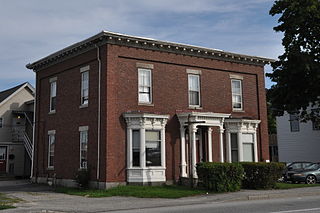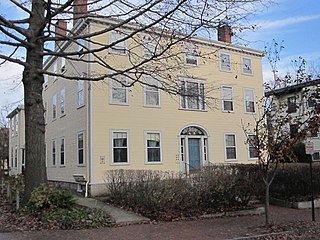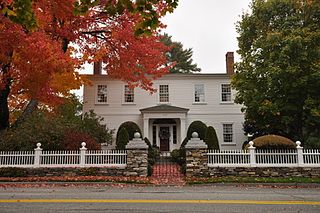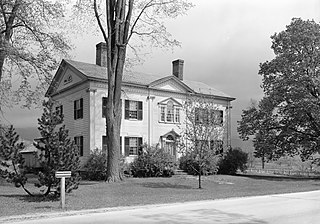
The Asa Gray House, recorded in an HABS survey as the Garden House, is a historic house at 88 Garden Street, Cambridge, Massachusetts. A National Historic Landmark, it is notable architecturally as the earliest known work of the designer and architect Ithiel Town, and historically as the residence of several Harvard College luminaries. Its most notable occupant was Asa Gray (1810–88), a leading botanist who published the first complete work on American flora, and was a vigorous defender of the Darwinian theory of evolution.

Swampscott Town Hall, previously the Elihu Thomson House, is a historic building in Swampscott, Massachusetts. The house was designed by architect James T. Kelley and built in 1889 for the noted inventor, electrical engineer, and industrialist Elihu Thomson (1853-1937). Thomson was, with Edwin J. Houston, co-founder of the Thomson-Houston Electric Company which would later merge with Thomas Edison's Edison General Electric Company to become the General Electric Company. The house was built with an observatory, which no longer exists. It has housed Swampscott town offices since 1944, when it was given to the town by Thomson's heirs. The building was declared a National Historic Landmark in 1976 for its association with Thomson.

The Samuel Russell House is a neoclassical house at 350 High Street in Middletown, Connecticut, built in 1828 to a design by architect Ithiel Town. Many architectural historians consider it to be one of the finest Greek Revival mansions in the northeastern United States. Town's client was Samuel Russell (1789-1862), the founder of Russell & Company, the largest and most important American firm to do business in the China trade in the 19th century, and whose fortunes were primarily based on smuggling illegal and addictive opium into China.

The Sarah Orne Jewett House is a historic house museum at 5 Portland Street in South Berwick, Maine, United States. The house was designated a National Historic Landmark in 1991 for its lifelong association with the American author Sarah Orne Jewett (1849–1909), whose influential work exemplified regional writing of the late 19th century. The house, built in 1774, is a high-quality example of late Georgian architecture. It is now owned by Historic New England, and is open for tours every weekend between June and October, and two Saturdays per month the rest of the year.

The Matthew Thornton House is a historic house and National Historic Landmark in Derry, New Hampshire. It was from 1740 to 1779 the home of Matthew Thornton, a signer of the U.S. Declaration of Independence.

The Wentworth-Gardner House is a historic mid-Georgian house, located at 50 Mechanic Street in Portsmouth, New Hampshire, United States. The house is operated as a museum by the Wentworth-Gardner Historic House Association. It is one of the finest extant examples of high-style Georgian architecture in New England, and played a role in the architectural preservation movement of the early 20th century. It was declared a National Historic Landmark in 1968.

The Wentworth Lear Historic Houses are a pair of adjacent historic houses on the south waterfront in Portsmouth, New Hampshire. Both buildings and an 18th-century warehouse are owned by the Wentworth Lear Historic Houses and are operated as a house museum. They are located at the corner of Mechanic and Gardner Streets. The two houses, built c. 1750–60, represent a study in contrast between high-style and vernacular Georgian styling. The Wentworth-Gardner House is a National Historic Landmark, and the houses are listed as the Wentworth-Gardner and Tobias Lear Houses on the National Register of Historic Places.

The Holland–Drew House is a historic house at 377 Main Street in Lewiston, Maine. Built in 1854, it is a high-quality local example of Italianate architecture executed in brick. It is also notable for some of its owners, who were prominent in the civic and business affairs of the city. The house was listed on the National Register of Historic Places in 1978.

Cannondale Historic District is a historic district in the Cannondale section in the north-central area of the town of Wilton, Connecticut. The district includes 58 contributing buildings, one other contributing structure, one contributing site, and 3 contributing objects, over a 202 acres (82 ha). About half of the buildings are along Danbury Road and most of the rest are close to the Cannondale train station .The district is significant because it embodies the distinctive architectural and cultural-landscape characteristics of a small commercial center as well as an agricultural community from the early national period through the early 20th century....The historic uses of the properties in the district include virtually the full array of human activity in this region—farming, residential, religious, educational, community groups, small-scale manufacturing, transportation, and even government. The close physical relationship among all these uses, as well as the informal character of the commercial enterprises before the rise of more aggressive techniques to attract consumers, capture some of the texture of life as lived by prior generations. The district is also significant for its collection of architecture and for its historic significance.

The Stephen Storm House is located on the NY 217 state highway just east of Claverack, New York, United States. It is a Federal style brick house built in the early 19th century.

The William Minott House is a historic house at 45 Park Street in Portland, Maine. It is one of Portland's few Federal period houses, notably surviving the city's devastating 1866 fire. It was listed on the National Register of Historic Places on July 10, 1979.

The Red Brick School is an historic school building on Warren Street in Wiscasset, Maine. Built in 1807 as a subscription-funded secondary school, it served in that role until 1923. It was added to the National Register of Historic Places listings in October 1970. It now houses an art gallery.

Wadsworth Hall, also known as the Peleg Wadsworth House, is a historic house at the end of Douglas Road in Hiram, Maine, United States. A massive structure for a rural setting, it was built for General Peleg Wadsworth between 1800 and 1807 on a large tract of land granted to him for his service in the American Revolutionary War. Wadsworth was the leading citizen of Hiram, and important town meetings took place at the house. He was also the grandfather of poet Henry Wadsworth Longfellow, who visited the estate as a youth. The house remains in the hands of Wadsworth descendants. The house was listed on the National Register of Historic Places in 1974.
The Elms, also known as the Boardman J. Stevens House and the George W. Richards House, is a historic house at 59 Court Street in Houlton, Maine. Built c. 1872 as a fine example of Second Empire architecture, it underwent a significant alteration between 1906 and 1912 in which high-quality Craftsman styling was introduced to its interior. The building was listed on the National Register of Historic Places in 2009 for its architectural significance.

The Royal Brewster House is a historic house on Brewster Lane in the Buxton Lower Corner village of Buxton, Maine, United States. Built in 1805, it is an imposing Federal style house in a relatively rural setting. It was built for Dr. Royal Brewster, the town physician for about 40 years, and was the home for many years of Brewster's brother John, a well-known deaf-mute itinerant painter of folk portraiture. The house was listed on the National Register of Historic Places in 1975.

The Munro-Hawkins House is a historic house on Vermont Route 7A in southern Shaftsbury, Vermont. Built in 1807, it is a well-preserved example of transitional Georgian-Federal period architecture, designed by local master builder Lavius Fillmore. It was listed on the National Register of Historic Places in 1973.

The Stephen Coffin House is a historic house at 170 Main Street in downtown Damariscotta, Maine. Built in the first decade of the 19th century, it is a fine local example of Federal style architecture, and is further distinctive for its ell, which is an early surviving example of an attached shop. The house served for many years as home to the Skidompha Public Library, and is now in commercial use. It was listed on the National Register of Historic Places in 1987.

The Col. Isaac G. Reed House, also known historically as Cutting's Folly, was a historic house at 60 Glidden Street in Waldoboro, Maine. Built in 1807, it was a sophisticated local example of Federal period architecture, with an unusual period bow-shaped room. It was listed on the National Register of Historic Places in 2005. It was destroyed by fire on April 2, 2017, and was subsequently removed from the register.

The Wiscasset Historic District is a 101-acre (41 ha) historic district that encompasses substantially all of the central village of Wiscasset, Maine. The district includes at least 22 contributing buildings and two other contributing sites, one being a cemetery whose oldest stone is from 1739. Located on the west bank of the Sheepscot River and settled in the 18th century, Wiscasset was a prominent harbor in Mid Coast Maine, and a major shipbuilding and merchant port, until the War of 1812 ended its prosperity. The village center includes fine examples of Federal period architecture, most built between about 1780 and 1820, including one National Historic Landmark, the Nickels-Sortwell House. The district was listed on the National Register of Historic Places in 1973.

The Wheeler-Beecher House is a historic house at 562 Amity Road in Bethany, Connecticut. Built in 1807, it is a good example of Federal period architecture, designed by New Haven architect David Hoadley. The house was listed on the National Register of Historic Places in 1977.





















